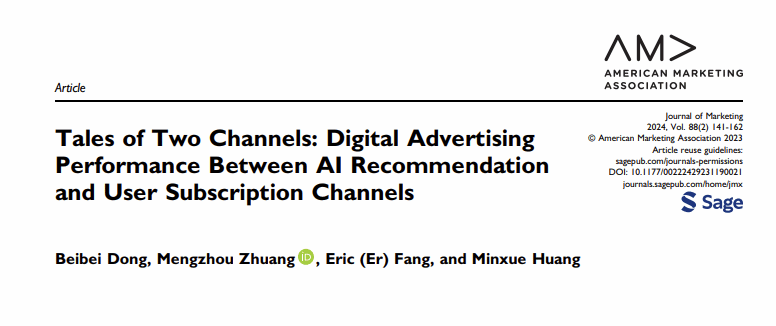Recently, a paper titled "Tales of Two Channels: Digital Advertising Performance Between AI Recommendation and User Subscription Channels" (Intelligent Recommendation or User Subscription? Unlock the Secrets of Social Advertising!) was officially published by the team led by Professor Huang Minxue from the Economics and Management School of Wuhan University in the top global business school journal Journal of Marketing (UTD24). The first author is Dong Beibei from Lehigh University in the US, the second is Zhuang Mengzhou from the University of Hong Kong, the third is Fang Er from Lehigh University in the US, and Huang Minxue is the corresponding author.

The research findings show that the platform can push content through user subscription ("follow") or intelligent recommendation ("recommendation"). Compared with subscription, consumers in the AI recommendation channel have lower participation in the content but perceive the advertisement as less intrusive. Thus, the advertisement click-through rate is higher but the conversion rate is lower. This paper contends that with the rapid development of artificial intelligence, social news platforms are no longer confined to the traditional user subscription method. Major platforms have adopted AI intelligent recommendation to present more personalized content to users. Whether it's domestic platforms like Weibo, WeChat, and Douyin, or popular online media platforms abroad such as Google, Twitter, and TikTok, users can freely choose between the two channels of "follow" and "recommendation". So, how do users interact with the content of these two channels? How does this interaction affect the effectiveness of advertising placement? Can enterprises achieve the maximum click-through rate and conversion rate through ingenious advertisement design?
This paper mainly studies the differences in the performance of information flow advertisements, such as click-through rate and conversion rate, between user subscription ("follow") and AI recommendation ("recommendation") channels. And whether these effects also rely on two attributes of the advertisement: advertisement content and advertisement link. The advertisement content can be informative (focusing on the factual information of the product) or emotional (emphasizing the product experience through subtle emotions). The advertisement link can be direct (for example, "Buy Now") or indirect (for example, "Click to Get More Information"). The article explores the relationship between the channel and consumers' information processing participation, analyzes the relationship between consumers' participation and their attitude towards advertisements, as well as conducts large-scale field experiments, three laboratory experiments, and one eye-tracking experiment, providing important practical implications for marketing managers: To maximize the click-through rate, advertisers should use emotional advertisements with indirect links in both subscription and recommendation channels. Conversely, to maximize the conversion rate, the subscription channel is suitable for using informative advertisements with indirect links, while the recommendation channel is suitable for using emotional advertisements with indirect links. At the same time, this research also brings significant social implications. Although intelligent recommendation can offer more personalized services, users' in-depth participation in the content is relatively low. In the long run, this may have an impact on users' critical thinking, deep learning, and creativity, especially considering that the younger generation spends a considerable amount of time on social platforms dominated by intelligent recommendation (such as Douyin), and this impact cannot be disregarded.
It is reported that Journal of Marketing is an academic journal ranked for global business schools, with a five-year impact factor of 15.2. This research work was funded by the key project of the National Natural Science Foundation of China.
 Faculty and Staff
Faculty and Staff Academics
Academics International Exchange
International Exchange







